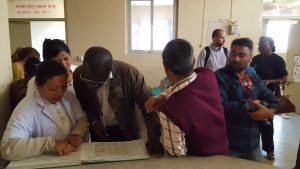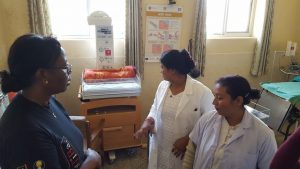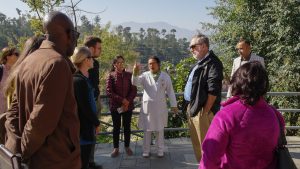
Sisu Global Health is bucking the business-as-usual approach to medical device design – by using human-centered design concepts to develop their medical technologies for patients and healthcare providers in emerging economies.
However, as co-founder Katie Kirsch can attest, a successful human-centered design approach requires early-stage global health innovators to gain extensive understanding of in-country context. That includes first-hand insight on customer experience by getting feedback on a prototype as well as understanding how the countries’ healthcare, governmental, and regulatory systems play a role in the product’s design.
“The creation and launch of our product, Hemafuse in Ghana and Kenya would not have been as successful without regular, immediate feedback from customers and critical healthcare partners or government stakeholders in each country,” said Kirsch.
Sisu’s commitment to learning regional context for the development and launch of their innovation paid off. Over the last few years, the team has earned grants and awards to further their efforts, including a $250k Saving Lives at Birth: A Grand Challenge for Development seed grant, and a $100k Rise of the Rest pitch competition award. More recently, the team received regulatory approval in both Kenya and Ghana, allowing the company to sell Hemafuse in two key African markets. Sisu also submitted a 510(k) notification to the U.S. FDA. Receiving this clearance will allow the company to more easily expand to new markets.
Why is it Important to Understand In-Country Context?
Early-stage innovators working to commercialize global health technologies face unique challenges when it comes to discovering and overcoming barriers to entry in emerging markets. For instance, each country has its own complexities when it comes to distribution, production, sales, regulations – even political and cultural nuances. And it goes without saying that understanding specific resource limitations and challenges when developing a product for emerging economies is critical.
Early-stage innovators boost their chances of success when they find ways to get first-hand exposure to how potential stakeholders and customers might interact with an innovation. It also helps to receive guidance from local partners when it comes to navigating the complicated process of entering a new global market.

Take Xcelerator participant and E-Team grantee, Ibrahim Mohedas of SubQ Assist. The team initially dedicated much of their time and resources to fine tuning the design while at the University of Michigan. They were convinced their assistive medical device would make it easier and safer for healthcare workers in low-resource settings to administer contraceptive implants. However, they didn’t dedicate much time thinking about the market and trying to validate customer demand. Essentially, they were working in isolation.
“We thought this was a great device that added real value for the Ministry of Health in Ethiopia,” said Mohedas. “We thought countries would adopt it because the device reduced overall healthcare costs. We didn’t appreciate the complexity of implementing and commercializing an idea like this. We were naive to the immense number of stakeholders and complexity of bringing the device to market. Once we stopped obsessing over the design needs of the end user and focusing more holistically on particular in-country needs, challenges, and opportunities, our idea started to take shape into a company with real commercial potential.”
Mohedas’ experience is not unique. Participants in our Saving Lives at Birth Xcelerator program often describe the in-country exposure to the many variables of launching a global health innovation as “eye-opening.” Program participants report pivoting on their technology or business model as a result of learning the specific needs or pain points facing the different local players and stakeholders potentially impacted by the innovation.
The fourth installment of the Innovator Insights Series addresses several reasons why it’s important for innovators to understand regional context when developing and launching an innovation in a foreign country: to better understand unique market challenges and customer needs, to foster critical partnerships and relationships, and to ensure project momentum.
We spoke with the following innovator-entrepreneurs, coaches, and experts involved with the Xcelerator program about in-country context:
- Katie Kirsch of Sisu Global Health
- Donna Brezinski of Little Sparrows Technologies
- Katie Clifford of PharmaChk
- Ibrahim Modehas of SubQ Assist
- Edward Bitarakwate of Elizabeth Glaser Pediatric AIDS Foundation (EGPAF)
- Michael Free, global innovation expert
- Laura Sampath and Christina Tamer, both of VentureWell
Identify Opportunities to Understand Regional Market Challenges and Customer Needs
Before launching any venture, it’s important for innovators to know the lay of the land. Unfortunately, commercializing in emerging markets doesn’t come with a guidebook. While many global health innovators have a general familiarity with the local research or commercialization environment – whether through travel or academic collaborations – they are rarely experts in commercializing products in those settings.
Case in point, nearly half of surveyed Xcelerator teams identified significant knowledge gaps about regional market challenges while attending the program. Specifically, their responses pointed to lacking:
1) a solid understanding of the target market
2) ideas for how to market and sell products or services in emerging economies
As one participant explained, “We have had several experiences in the developing world, so we understand the complexities of creating a technology there. However, we quickly realized that we have little experience with commercializing a product, especially in the highly variable market that exists in emerging economies.”

These findings illustrate that, during the initial design and development phases, global health innovators benefit greatly from attending in-country trainings to help gather insights into some of the issues they are bound to encounter as they progress towards commercialization. Xcelerator participants in programs in Rwanda and Malawi speak to the value of even short-term opportunities to experience sites where an innovation could be deployed. As one innovator wrote, “We left with a very different lens toward working in emerging economies. Coming from a developed country, we had little or no experience collaborating with institutions in low-resource settings. The program was immensely helpful in advancing our understanding of context, priorities, and cultural factors that differ between the two. It was instrumental in our success executing our current pilot.”
These experiences often help inform new design approaches as well. “The site visits were valuable in getting me to understand the context in which our innovations would be used. It is also causing me to consider re-evaluating the design.”
Once innovators assess the local challenges and opportunities that they identified during a program, it’s important for them to strategize whether they need to be in the target country on a regular basis, or if they will find others to be their eyes and ears on site. According to VentureWell venture development officer Christina Tamer, innovators benefit greatly from actually working and immersing themselves in the country. “You won’t truly understand the market unless you’re there. The feedback loop is too slow. Ideally, innovators should be on the ground during the launch phase and be building a strategy for a sustained enterprise.”
Unfortunately, it’s not always feasible for inventor-entrepreneurs to dedicate a long period of time living abroad. For innovator Donna Brezinski, finding trusted locally-based collaborators to work with allowed her to spend less time away from home and her family. “These types of projects are very difficult to launch without champions on the ground who are in constant communication with you, offering guidance, or making introductions. We were fortunate to have support from local experts who wanted to see the innovation succeed.”
Like learning the ins-and-outs of in-country market challenges, innovators early in their development phase must understand specific customer needs. This allows them to target and fine tune their products to better address the complexities of specific consumers. As Brezinski explained, “When I traveled throughout the world with my prototype, we came away with a more comprehensive understanding of what improvements were needed in order to solve the customer’s problem.”
An Xcelerator participant echoed this sentiment. “It was very inspiring to see one of the settings in which our innovation might be used, to see the technical hurdles we would face, and the everyday challenges that would present themselves. We have made modifications to our innovation that allow it to be implemented in lower resource environments.”
As we’ve learned from Xcelerator participants and coaches, early-stage global health innovators require deep in-country immersion to truly know how to enter and navigate complex global markets. “While trainings provide real-time exposure to the inner workings of a country’s various stakeholders and gatekeepers, it’s important for global health innovators to be on the ground during the launch phase and to work with regional champions from the start in order to successfully kickstart their journey,” said Laura Sampath, VentureWell Vice President of Programs and Xcelerator coach.
Build the Right Partnerships and Relationships
According to the Xcelerator innovation experts, it’s important that innovators not simply rely on academic collaborators to understand the nuances of launching a global health company. Successful innovators also work to foster in-country relationships with key stakeholders and gatekeepers in healthcare settings, regulatory agencies, and government bodies.
Innovation expert Michael Free explains that, “Commercializing in emerging markets is a complex process, and there are so few clearly defined protocols for innovators to follow. Successfully navigating that terrain requires innovators to work closely with in-country collaborators and stakeholders who know the ins-and-outs of customer discovery, regulatory hurdles, public health policies, and so on.”

Early-stage innovators we spoke with agree. According to Xcelerator participant and PharmaChk teammate, Katie Clifford, “Initially, we thought PharmaChk would be used almost exclusively in rural clinic settings. We met a local drug quality expert who provided a different perspective to how the technology could be used, helping us understand that the points where PharmaChk would be most impactful would be further up the supply chain, and not necessarily in a rural clinic or hospital. That was a valuable pivot point. That same person also became an integral part to our field trials. He connected us with the right people and institutions. Finding this knowledgeable, trustworthy partner who understood the local context helped us make the right decisions.”
Brezinski’s relationship with her pilot partners also played an important role during her company’s design and research phase. “Our perception of the clinical challenges was only part of the story. They showed us that the problem wasn’t just getting treatment to patients, it was also getting them diagnosed. Only after we started to work with field test sites and develop a relationship with them did we develop an understanding of those other facets and begin to innovate relative to diagnosis as well as treatment.”
We also learned that early-stage innovators benefit from developing relationships with other entrepreneurs working in the same space. “We were introduced to a peer company during the Xcelerator program,” said Kirsch. “While they are a medical device distributor based in the U.S., they work closely with medical institutions in Africa. They are very aware of the complexities of launching a health startup in this part of the world. Over the past few years, they’ve become a valuable informal partner. They speak our language. We’re able to bounce ideas off of them and brainstorm possible solutions to roadblocks.”
Innovators can leverage trainings to identify potential members of a support network and start relationships with them. For one Xcelerator team, having the opportunity to meet with critical stakeholders made all the difference for the project. They said, “We knew no one working in our field in Africa prior to the Xcelerator program. We made connections during the program that led to an introduction to the Director General of the East, Central, and Southern Africa Health Community as well as to the president of the colleges of surgeons, obstetricians and associate clinicians. These introductions eventually led to critical pilot programs for our project.“
Maintain Momentum of the Project
While in-country relationships inform strategy, they also help ensure a project stays on track. “From a logistical standpoint, conducting the majority of our work on the ground allowed the project to maintain a steady momentum,” said Kirsch. “Had we tried to manage all of the design and business-building activities from the U.S., we would not be as far along in our journey.”
Kirsch further explains the reasoning behind dedicating so much of her time living and working in Ghana. “It’s important to have face time with our in-country customers and partners. I’ve learned that, to get anything going, it’s very helpful to actually be here. Once you leave, things slow down. People don’t interact on email as much unless you have a long term relationship. If I leave after initiating a relationship, even for a week or two, people will say they’ll talk when I’m back in the country, even though we can easily communicate by email. In my experience, projects slow down if I’m not present.”

Having a long-standing presence on the ground also ensures innovators can pivot and adjust innovation designs more nimbly. Take Xcelerator participant Edward Bitarakwate. He’s based in the rural settings where his organization hopes to have the greatest impact. As he explained, “I’m where the rubber hits the road. That’s a big advantage. I’m able to quickly adjust what I’m doing as a result of on-the-ground observations or respond to any changes that need to be made.”
And changes are frequent in the early stages of development. Bitarakwate elaborates: “Assumptions made months ago may not be correct now, or you may have started a plan but there will be a whole new set of people implementing it. Sometimes you have to go back to the starting point. If I were working remotely, it would be very difficult to address these changes quickly. I fear the project would stall.” Bitarakwate also notes that being on the ground provides him with access to key problem solvers. “I have access to the right people and organizations that will help me get the job done.” Frequent starts and stops in the early stages of a project can be detrimental to a team’s progress and success. “Seeing progress is not only important for the team’s morale, it shows potential partners and investors that you’re capable of running a business,” said Sampath. “Being on the ground or having very committed and motivated local partners greatly increases the chances that a project will maintain momentum.”
Customer discovery is increasingly a basic tenet of innovation development, but most teams continue to need guidance about when to factor that in during the initial phase of their journey. Our takeaway from speaking with innovation veterans is that it’s never too early to build relationships, partnerships, and in-depth, experiential knowledge of in-country contexts. That knowledge can be a primary driver in the innovation design process – making it possible to factor different variables sooner rather than later so as to save time in ensuring actual efficacy and feasibility. That knowledge can also inform the development of a sustainable business model that relates to customers as well as the larger governmental and regulatory systems that will ultimately structure success or drive failure. And while understanding of end-user groups and regional systems is critical, operationalizing that understanding happens best through direct relationships with local champions and people on the ground working in the sites where an innovation could improve and save lives.
The last article in our Innovator Insights Series will take a close look at the importance of strategy development.
Other Installments in the Innovator Insights Series
Preparing for the Innovation and Entrepreneurship Journey
Mastering Strategy Development